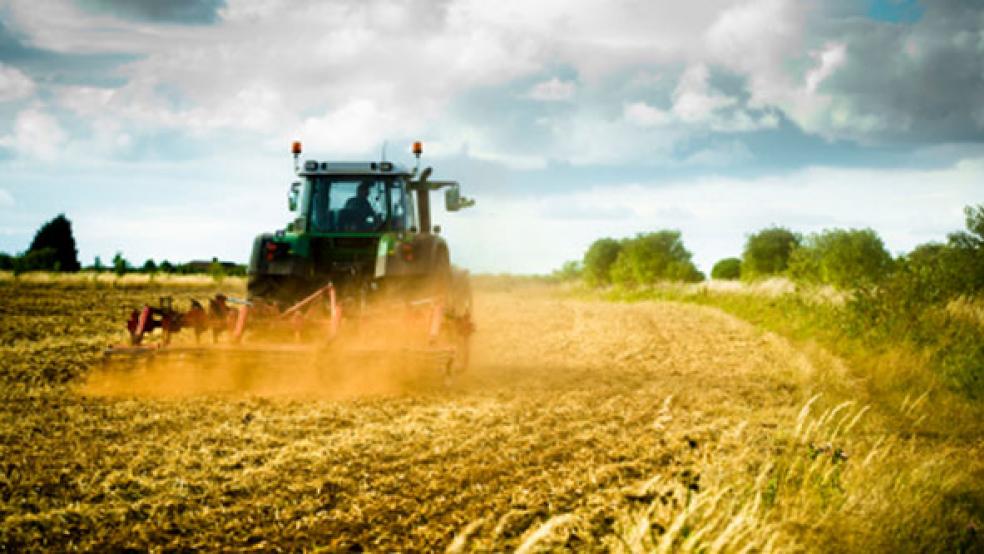The scorching summer – and consequent crop damage – is prompting frantic calls to pass a new farm bill. A version of the every-five-years legislation, which will replace the existing law due to expire at the end of September, has passed the Senate and the House Agricultural Committee, but is now stuck. Republicans are trying to wring greater savings out of the $500 billion potpourri of programs, and rightly so. Though senators from both sides of the aisle have congratulated themselves on trimming this pork-packed bill, authorized spending would be 60 percent higher than under the 2008 law. Taxpayers should demand that Congress scrap this monstrosity and start over.
The farm package is yet another 1,000-page atrocity as packed with goodies as a stuffed olive. There are 1,063 lobbyists feverishly pressing their case. In 2008, influence-peddlers spent $173.5 million on the farm bill – more than on Obamacare; this year the cash bash could be even higher. That says everything.
Maybe we should limit new bills to 100 pages or less. Like Peter Rabbit in the briar patch, nearly anything can hide if the thicket’s big enough. What’s hidden in this mess? How about money for windmills, for 15 different duplicative food programs, cash – lots of it – to make sure country folk get great Internet service, a grant to study moth pheromones, funding to help ethanol producers (thought we’d gotten rid of that, didn’t you?), protection of our wealthy sugar producers, $25 million to study the health benefits of peas and lentils, an amendment that could allow Californians to continue enjoying foie gras, insurance against lower milk prices for dairy farmers, grants for the locavore movement (consult your dictionary), help for popcorn growers, grants to study how to make cut flowers last longer in a vase, a boost to organic growers (as though their price premiums aren’t sufficient compensation), a boost for maple syrup makers, lofty cotton supports and money to underwrite wine tastings overseas.
Leaving off the food stamps portion of the bill, taxpayers are essentially underwriting one of our richest industries. Farmers enjoyed record income last year and saw their land values hit all-time highs, while the rest of the country struggled.
First off, there is no reason to include food stamps, or the Supplemental Assistance Nutrition Program (SNAP), in the farm bill. Republicans call it a bloated entitlement riddled withfraud and waste. Democrats call it essential to the well-being of our poor. This is undisputed: the program has doubled in size since President Obama took office. We spent $39 billion on SNAP in 2008; this year the expected total is $81 billion. A jump of that magnitude deserves scrutiny.
The left-leaningCenter for American Progress is horrified that the House committee agreed to slice the food stamp budget by $1.6 billion per year. They claim that every $1 billion cut in SNAP costs the country 14,000 jobs, suggesting that the program is a stealth stimulus plan. Is it the best way to prop up the economy?
Perhaps the worst feature of the food stamp program is that it provides cover for the myriad gifts doled out to special interests, which probably suits our legislators just fine. Make no mistake – the pork in the farm bill is lavender – serving both blue and red states. While Democratic Senator Patrick Leahy works to protect Vermont dairy farmers from the vicissitudes in milk prices, (courtesy of the Milk Income Loss Contract), Iowa’s GOP Senator Grassley likes subsidized crop insurance.
This time round, displaying at least some awareness that farmers are doing just fine, as President Obama might say, both the Senate and the House Agricultural Committee have made cuts to farm supports -- eliminating $5 billion in yearly direct payments to those who plant corn, soybeans and other products. Unfortunately, the savings were not directed back to taxpayers, but instead went mainly to expanding the insurance subsidies available to farmers. If crops wither, as may be happening today, most farmers – other than the wealthiest in the land –would be protected. Dean Norton, the head of New York’s Farm Bureau, recently said, “Uncertainty is a big negative in the agriculture industry.” He must not have read the farm bill.
Republican Senator Frank Lucas of Oklahoma describes his chamber’s bill as “reform-minded” and “fiscally responsible.” Some perspective is needed. Over ten years, the Senate version cuts a near-trillion dollar program by $23 billion, while the House Agricultural Committee removes $35 billion – or only 2 percent to 3 percent -- from the amount indicated by current law.
Jim DeMint (R-SC) is not happy with Congress’ efforts. He reports in a cranky memo that Senate Democrats refused to make any cuts to $772 billion in expected food stamp spending, and accused them of blocking 16 GOP amendments aimed at saving money while approving some 30 measures that hike outlays and increase regulations. Only one program was eliminated – a redundant catfish inspection effort. DeMint sponsored an amendment that expressed disapproval of the farm bill interfering with free markets; it passed by voice vote. Then the Senate set to work and devised hundreds of ways in which to interfere with the free markets in our farm products. No wonder he’s cranky.






